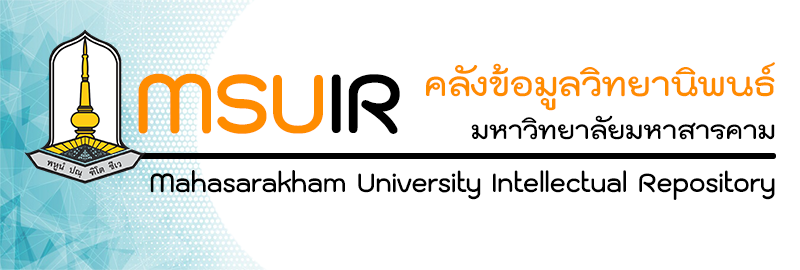Please use this identifier to cite or link to this item:
http://202.28.34.124/dspace/handle123456789/2763| Title: | The Development of an Effective Academic Administration Participatory of Parent and Community Model in Small Size Schools การพัฒนารูปแบบการบริหารงานวิชาการที่มีประสิทธิผลแบบมีส่วนร่วม ของผู้ปกครองและชุมชนในโรงเรียนขนาดเล็ก |
| Authors: | Krisna Kittilap กฤษณา กิตติลาภ Suwat Junsuwan สุวัฒน์ จุลสุวรรณ์ Mahasarakham University Suwat Junsuwan สุวัฒน์ จุลสุวรรณ์ suwat.j@msu.ac.th suwat.j@msu.ac.th |
| Keywords: | การพัฒนารูปแบบ การบริหารงานวิชาการที่มีประสิทธิผล การบริหารแบบมีส่วนร่วมของผู้ปกครองและชุมชน Components of Academic Administration Effective Academic Administration Participation Administration |
| Issue Date: | 7 |
| Publisher: | Mahasarakham University |
| Abstract: | The present study aimed 1) to examine the components, the current state, the desired state and needs of the effective academic administration with participation of parents and community in small-sized schools, 2) to develop the model of effective academic administration with participation of parents and community in small-sized schools, and 3) to investigate the implementation the model of effective academic administration with participation of parents and community in small-sized schools. The research design was research and development and mixed–method, divided into 3 phases. Phase 1: examine the components, the current state, the desired state and needs of the effective academic administration with participation of parents and community in small-sized schools comprised of 3 steps; 1) synthesis the documents and related studies by in-depth interview method, the components were evaluated by 7 experts selected by purposive sampling, content analysis was used to analyze the data, 2) examine the current state, the desired state and needs, the sample were 379 consisted of schools’ administrators and teachers who responsible for the head of academic department selected by using simple random sampling, 3) studying 3 primary schools where there was the best practicing by interview the schools’ administrators, the participants selected by purposive sampling. Phase 2: development of the model divided into 2 steps; 1) drafting the model, 2) model verification by using focus group discussion, the informants were 15 experts selected by purposive sampling. Phase 3: investigate the implementation the model consisted of 4 steps; 1) compare learning achievement before and after learning of students in schools where the model was implemented, 2) study the results of ordinary national educational test (O-NET), 3) investigate the teachers’ satisfaction, and 4) evaluate teachers’ behaviors. The informants were the school’s administrators. The instruments used were interview form, questionnaire and evaluation form, the statistic used were frequency, percentage, mean, standard deviation, index of congruence (IOC) and priority needs index (PNI modified).
The results of the study revealed as follows;
1. The results of examine the components, the current state, the desired state and needs of the effective academic administration with participation of parents and community in small-sized schools shown the following; 1) there were 4 main components and 24 sub - components of the effective academic administration with participation of parents and community in small-sized schools, the results of appropriateness evaluation rated as high level, 2) the results of current state rated as high level while the desired state rated as high level also. When assessing the needs, it is found that the component with the highest need is processing participatory, scopes of academic administration, model’s components, and academic administration process respectively, 3) the guidelines for an effective academic administration with participation of parents and community in small-sized schools comprised of materials, innovation and educational technology development, learning process development, research for educational quality development, learning resources development and school’s curriculum development.
2. Development the model of effective academic administration with participation of parents and community in small-sized schools, the results revealed that the model consisted of 6 parts with the appropriateness, the feasibility, and the benefits overall rated as high level.
3. The results of implementation the model of an effective academic administration with participation of parents and community in small-sized schools shown that 1) students’ learning achievements after implementing the model are higher with the mean scores are 97.00 or 97 of percentage. When comparing with the criteria, it is higher than the criteria at .05 statistic significantly, 2) the results of the ordinary national educational test (O-NET) of the two schools, overall are higher with the mean of difference (+ 0.89 and + 2.98), 3) teachers have highly satisfied after the implementation of the model, and 4) the teachers’ behaviors after implementation the model overall rated as the highest level, and the results of post-test are higher at .05 statistic significantly. การวิจัยครั้งนี้มีความมุ่งหมายเพื่อ 1. ศึกษาองค์ประกอบ สภาพปัจจุบัน สภาพที่พึงประสงค์ ความต้องการจำเป็นและแนวทางการบริหารงานวิชาการที่มีประสิทธิผลแบบมีส่วนร่วมของผู้ปกครองและชุมชนในโรงเรียนขนาดเล็ก 2. พัฒนารูปแบบการบริหารงานวิชาการที่มีประสิทธิผลแบบมีส่วนร่วมของผู้ปกครองและชุมชนในโรงเรียนขนาดเล็ก 3. ศึกษาการใช้รูปแบบการบริหารงานวิชาการที่มีประสิทธิผลแบบมีส่วนร่วมของผู้ปกครองและชุมชนในโรงเรียนขนาดเล็ก โดยใช้กระบวนการวิจัยและพัฒนา (Research and Development) ใช้ระเบียบวิธีวิจัยผสมผสาน วิธีการเก็บข้อมูลเชิงปริมาณและเชิงคุณภาพ แบ่งเป็น 3 ระยะ ระยะที่ 1 ศึกษาองค์ประกอบ สภาพปัจจุบัน สภาพที่พึงประสงค์ ความต้องการจำเป็นและแนวทางการบริหารงานวิชาการที่มีประสิทธิผลแบบมีส่วนร่วมของผู้ปกครองและชุมชนในโรงเรียนขนาดเล็ก แบ่งเป็น 3 ขั้นตอน 1. ศึกษาองค์ประกอบ จากเอกสารงานวิจัยและการสัมภาษณ์เชิงลึก (In-depth Interview) ประเมินองค์ประกอบโดยผู้ทรงคุณวุฒิ ใช้การเลือกแบบเจาะจง (Purposive Sampling) จำนวน 7 คน ใช้การวิเคราะห์เนื้อหา (Content Analysis) 2. ศึกษาสภาพปัจจุบัน สภาพที่พึงประสงค์ ความต้องการจำเป็น กลุ่มตัวอย่าง ได้แก่ ผู้บริหารสถานศึกษา หัวหน้ากลุ่มบริหารงานวิชาการหรือครู จำนวน 379 คน ใช้วิธีการสุ่มอย่างง่าย (Simple Random Sampling) 3. ศึกษาแนวทางวิธีการปฏิบัติที่ดีในโรงเรียนประถมศึกษา 3 แห่ง โดยการสัมภาษณ์ผู้บริหารสถานศึกษา ใช้การเลือกแบบเจาะจง (Purposive Sampling) จำนวน 3 คน ด้วยการวิเคราะห์เนื้อหา (Content Analysis) ระยะที่ 2 การพัฒนารูปแบบ 2 ขั้นตอน 1) ยกร่างรูปแบบ 2) การประเมินความเหมาะสม ความเป็นไปได้และความเป็นประโยชน์ ด้วยวิธีการสนทนากลุ่ม (Focus Group Discussion) ผู้ทรงคุณวุฒิ จำนวน 15 คน ด้วยการเลือกแบบเจาะจง (Purposive Sampling) ระยะที่ 3 การใช้รูปแบบการบริหารงานวิชาการที่มีประสิทธิผลแบบมีส่วนร่วมของผู้ปกครองและชุมชนในโรงเรียนขนาดเล็ก 4 ขั้นตอน 1) การเปรียบเทียบผลสัมฤทธิ์ทางการเรียนก่อนและหลัง 2) การเปรียบเทียบผลทดสอบทางการศึกษาระดับชาติขั้นพื้นฐาน 3) การประเมินความพึงพอใจของครู ผู้ให้ข้อมูล ได้แก่ ครูและบุคลากรที่ใช้รูปแบบ จำนวน 10 คน 4) การประเมินพฤติกรรมของครู ผู้ให้ข้อมูล คือ ผู้บริหารสถานศึกษา เครื่องมือที่ใช้ในการวิจัย ได้แก่ แบบสัมภาษณ์ แบบสอบถาม แบบประเมิน สถิติที่ใช้วิเคราะห์ข้อมูล ได้แก่ ค่าความถี่ ค่าร้อยละ ค่าเฉลี่ยและส่วนเบี่ยงเบนมาตรฐาน ค่าความต้องการจำเป็น (Priority Needs Index: PNI) และการวิเคราะห์เนื้อหา (Content Analysis) ผลการวิจัย พบว่า 1. องค์ประกอบ สภาพปัจจุบัน สภาพที่พึงประสงค์ ความต้องการจำเป็นและแนวทางการบริหารงานวิชาการที่มีประสิทธิผลแบบมีส่วนร่วมของผู้ปกครองและชุมชนในโรงเรียนขนาดเล็ก พบว่า 1) องค์ประกอบของการบริหารวิชาการที่มีประสิทธิผลแบบมีส่วนร่วมของผู้ปกครองและชุมชนในโรงเรียนขนาดเล็ด มี 4 องค์ประกอบหลัก 24 องค์ประกอบย่อย โดยรวมมีความเหมาะสมอยู่ในระดับมาก 2) สภาพปัจจุบันโดยรวมอยู่ในระดับมาก สภาพที่พึงประสงค์โดยรวมอยู่ในระดับมากที่สุด ลำดับความต้องการจำเป็นเรียงลำดับจากมากไปหาน้อย ได้แก่ กระบวนการบริหารแบบมีส่วนร่วม ขอบข่ายการบริหารงานวิชาการ องค์ประกอบของรูปแบบ และประสิทธิผลของการบริหารงานวิชาการแบบมีส่วนร่วม 3) แนวทางการบริหารงานวิชาการที่มีประสิทธิผลแบบมีส่วนร่วมในโรงเรียนที่มีวิธีปฏิบัติที่ดี ได้แก่ การพัฒนาสื่อ นวัตกรรมและเทคโนโลยีเพื่อการศึกษา การพัฒนากระบวนการเรียนรู้ การวิจัยเพื่อพัฒนาคุณภาพการศึกษา การพัฒนาและส่งเสริมให้มีแหล่งเรียนรู้ และการพัฒนาหลักสูตรสถานศึกษา 2. การพัฒนารูปแบบการบริหารวิชาการที่มีประสิทธิผลแบบมีส่วนร่วมของผู้ปกครองและชุมชนในโรงเรียนขนาดเล็ก พบว่า 1) รูปแบบ มี 6 ส่วน 2) ความเหมาะสม ความเป็นไปได้และความเป็นประโยชน์ โดยภาพรวมอยู่ในระดับมาก 3. การใช้รูปแบบการบริหารงานวิชาการที่มีประสิทธิผลแบบมีส่วนร่วมของผู้ปกครองและชุมชนในโรงเรียนขนาดเล็ก พบว่า 1) ผลสัมฤทธิ์ทางการเรียนก่อนและหลังการการใช้รูปแบบ มีคะแนนเฉลี่ยเท่ากับ 97.00 คะแนน คิดเป็นร้อยละ 97 เมื่อเปรียบเทียบระหว่างเกณฑ์กับคะแนนสอบของผู้เรียนสูงกว่าเกณฑ์อย่างมีนัยสำคัญทางสถิติที่ระดับ .05 2) ผลทดสอบทางการศึกษาระดับชาติขั้นพื้นฐาน (O-NET) โดยภาพรวมคะแนนเฉลี่ยสูงขึ้น (ผลต่างคะแนนเฉลี่ยเท่ากับ + 0.89, + 2.98) 3) ความพึงพอใจของครูต่อรูปแบบ ก่อนใช้โดยรวมอยู่ในระดับมากและหลังใช้โดยรวมอยู่ในระดับมากที่สุด 4) พฤติกรรมการเปลี่ยนแปลงของครูหลังการใช้รูปแบบโดยรวมอยู่ในระดับมากที่สุด และผลการทดสอบความรู้ก่อนและหลังมีคะแนนทดสอบความรู้หลังการพัฒนาสูงขึ้นอย่างมีนัยสำคัญทางสถิติที่ระดับ .05 |
| URI: | http://202.28.34.124/dspace/handle123456789/2763 |
| Appears in Collections: | The Faculty of Education |
Files in This Item:
| File | Description | Size | Format | |
|---|---|---|---|---|
| 61010562002.pdf | 10.85 MB | Adobe PDF | View/Open |
Items in DSpace are protected by copyright, with all rights reserved, unless otherwise indicated.

